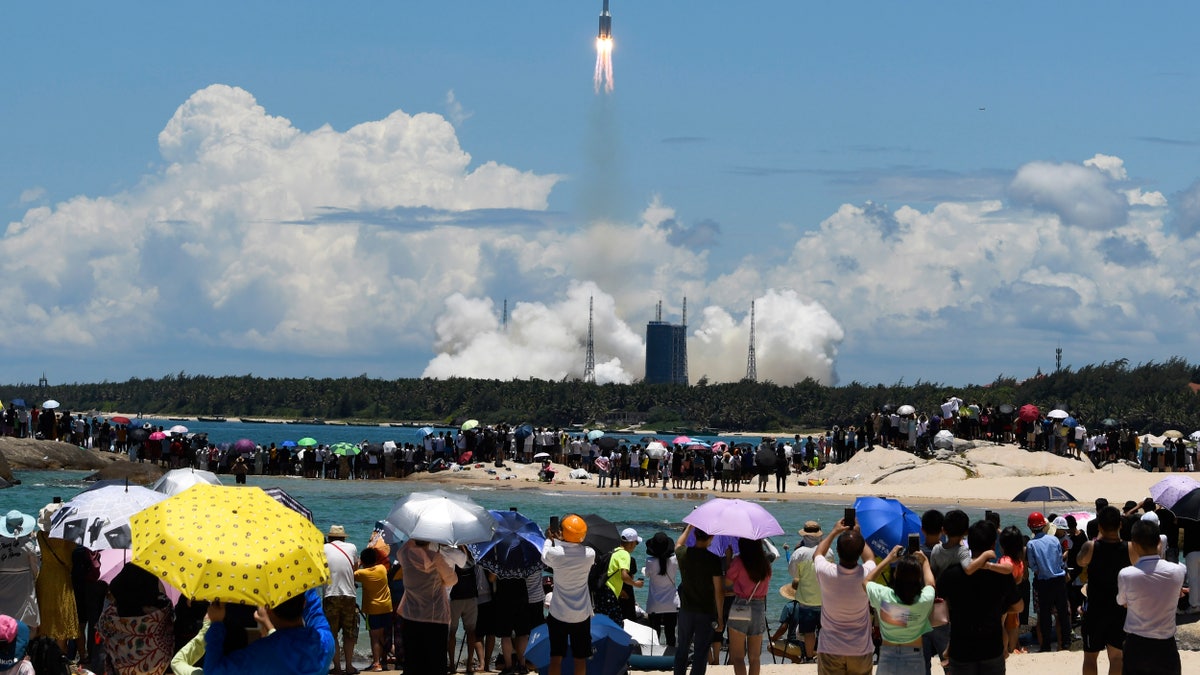Fox News Flash top headlines for July 22
Fox News Flash top headlines are here. Check out what's clicking on Foxnews.com.
China launched its first fully homegrown Mars mission on Thursday as it attempts to join the United States in successfully landing a spacecraft on the red planet.
The Tianwen-1 mission launched on top of a Long March-5 carrier rocket around 12:40 p.m. from Hainan Island, south of China's mainland. China’s tandem spacecraft — with both an orbiter and a rover — is scheduled to reach Mars in about seven months.
“It’s amazing that another nation has launched the case for Mars,” said Dr. Katarina Miljkovic, a planetary scientist at Curtin University in Australia. “It’s more like this marathon of space that we all want to be running.”
TOM COTTON RIPS NY TIMES FOR RUNNING CHINA SCIENTIST'S OP-ED SLAMMING US VIRUS RESPONSE
If everything goes as planned, it will be China's first successful mission to Mars, following a failed attempt back in 2011. During that attempt, a Chinese orbiter accompanying a Russian mission was lost when the spacecraft failed to get out of Earth’s orbit after launching from Kazakhstan. It eventually burned up in the atmosphere.
Meanwhile, China's Long March-5 rocket failed to launch earlier this year.

Spectators watch as a Long March-5 rocket carrying the Tianwen-1 Mars probe lifts off from the Wenchang Space Launch Center in southern China's Hainan Province, Thursday, July 23, 2020. China launched its most ambitious Mars mission yet on Thursday in a bold attempt to join the United States in successfully landing a spacecraft on the red planet. (Yang Guanyu/Xinhua via AP)
Launch commander Zhang Xueyu said the rocket was flying normally for about 45 minutes after it took off.
“The Mars rover has accurately entered the scheduled orbit," he said in brief remarks shown live on state broadcaster CCTV.
The rocket carried the probe for 36 minutes before placing it on the looping path. It's set to go beyond Earth's orbit before eventually reaching into Mars’ more distant orbit around the sun.
The next challenge is for the probe to be "still working when it gets to Mars and survives entry and landing,” said Dr. Jonathan McDowell, an astronomer at the Harvard-Smithsonian Center for Astrophysics.
NASA'S MARS 2020 PERSEVERANCE ROVER: WHAT YOU NEED TO KNOW
In an article published earlier this month in Nature Astronomy, mission chief engineer Wan Weixing said Tianwen-1 would slip into orbit around Mars in February before a landing is attempted in April or May,

A Long March-5 rocket carrying the Tianwen-1 Mars probe lifts off from the Wenchang Space Launch Center in southern China's Hainan Province, Thursday, July 23, 2020. China launched its most ambitious Mars mission yet on Thursday in a bold attempt to join the United States in successfully landing a spacecraft on the red planet. (Cai Yang/Xinhua via AP)
It marked the second flight to Mars this week, after a United Arab Emirates orbiter blasted off on a rocket from Japan on Monday. The U.S. is aiming to launch Perseverance, its most sophisticated Mars rover ever, from Cape Canaveral, Fla., next week.
Landing on Mars is notoriously difficult. Only the U.S. has successfully landed a spacecraft on Martian soil, doing it eight times since 1976. NASA's InSight and Curiosity rovers still operate today. Six other spacecraft are exploring Mars from orbit: three American, two European and one from India.
CLICK HERE FOR THE FOX NEWS APP
China’s secretive space program has developed rapidly in recent decades. Yang Liwei became the first Chinese astronaut in 2003, and last year, Chang’e-4 became the first spacecraft from any country to land on the far side of the moon.
The Associated Press contributed to this report
